Introduction
Like many contemporary cultures, the ancient Romans tended to view their mythological tradition as being borne by history rather than legends, with the central themes related to politics, morality, and heroism. And since we are talking about history, while a perceptible scope of the ancient Roman gods and religion had its roots in native Italic traditions, a significant part of the institution (before Christianity) was inspired by Greek mythology, partially fueled by the proximity of the Greek colonies in both Italy and Sicily (and later absorption of mainland Greece into the Roman Republic).
In any case, beyond origins and influences, the ancient Romans tended to venerate twelve major gods and goddesses in their pantheon, known as the Dii Consentes. We have covered all of them and more, including a few examples of both primeval and syncretic deities. So without further ado, let us take a gander at 15 major Roman gods and goddesses you should know about.
Contents
- Introduction
- Saturn – The God of Time (Equivalent of Greek Kronos)
- Jupiter – The God of Sky and Thunder (Equivalent of Greek Zeus)
- Juno – The Queen of Gods (Equivalent of Greek Hera)
- Neptune – The God of Seas (Equivalent of Greek Poseidon)
- Minerva – The Goddess of Wisdom and Arts (Equivalent of Greek Athena)
- Mars – The God of War (Equivalent of Greek Ares)
- Venus – The Goddess of Beauty and Love (Equivalent of Greek Aphrodite)
- Apollo – The God of Light and Prophecy (Similar to the Greek Apollo)
- Diana – The Goddess of Hunt and The Moon (Equivalent of Greek Artemis)
- Vulcan – The God of Fire and Metallurgy (Equivalent of Greek Hephaistos)
- Vesta – The Goddess of Domesticity (Equivalent of Greek Hestia)
- Mercury – The God of Wealth (Equivalent of Greek Hermes)
- Ceres – The Goddess of Agriculture (Equivalent of Greek Demeter)
- Bacchus – The God of Wine and Revelry (Equivalent of Greek Dionysus)
- Honorable Mention – Mithras: The ‘Syncretic’ God
- Family Tree of Roman Gods and Goddesses
Saturn – The God of Time (Equivalent of Greek Kronos)
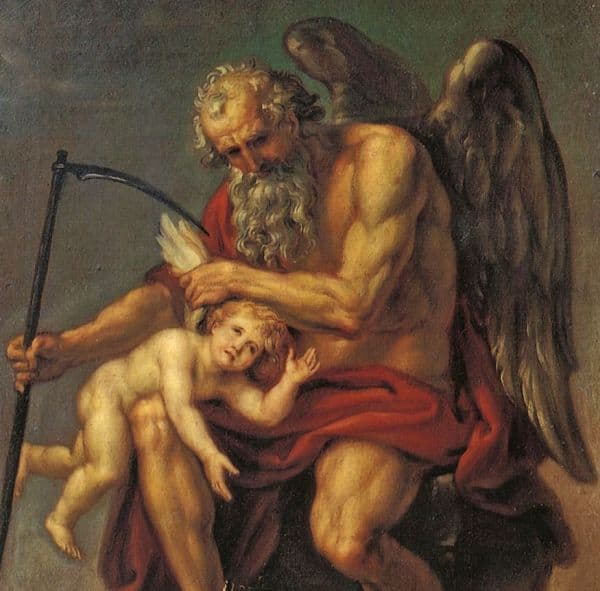
Alluding to a primeval deity among the ancient Roman gods, Saturn (Saturnus in Latin)was regarded as the ruler of the earth during the ‘lost’ Golden Age that epitomized the balance between peace, harmony, stability, and prosperity. Essentially, Saturn’s story replicates the lore of
Cronus in Greek mythology, thus making Saturn the god of time, who in turn proceeds to create the genealogy of other Roman gods, including being the father of Jupiter – the most important ancient Roman deity (discussed in the next entry). According to 1st century BC Stoic philosopher Quintus Lucilius Balbus (as noted by Cicero in his book De Natura Deorum or ‘On the Nature of the Gods’) –
By Saturn, they seek to represent that power that maintains the cyclic course of times and seasons. This is the sense that the Greek name of that god bears, for he is called Kronos, which is the same as Chronos or Time. Saturn for his part got his name because he was “sated” with years; the story that he regularly devoured his own children is explained by the fact that time devours the courses of the seasons and gorges itself “insatiably” on the years that are past. Saturn was enchained by Jupiter to ensure that his circuits did not get out of control and to constrain him with the bonds of the stars.
However, at the same time, Saturn also bore many similarities with the Greek goddess Demeter, wherein he was venerated as the god of sowing (or seed), agriculture, wealth, generation, and even renewal. Simply put, the Romans possibly merged the aspects of time and nature, thus leading to the epitomizing of revitalization and regeneration via the entity of Saturn.
And thus he was celebrated in the most famous of Roman festivals – the Saturnalia, during which people took part in general revelry, carnivals, parties, and role-reversals (like in the case of masters playfully serving their slaves).
Jupiter – The God of Sky and Thunder (Equivalent of Greek Zeus)
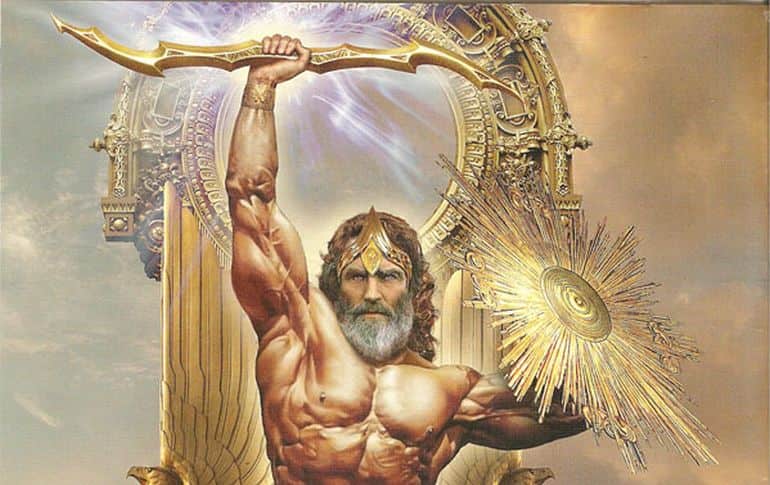
Considered the supreme deity among the Roman gods, Jupiter (Iūpiter in Latin)was portrayed as a bearded male entity who personified the light, thunder, and sky; while representing the divine being that was responsible for protecting the Roman state and its laws.
Interestingly enough, when it comes to history, Jupiter was one of the personalized deities of the Etruscan kings, who later made his way into the triad of gods (consisting of Jupiter, Mars, and Quirinus – the deified Romulus) worshipped by the ‘first’ citizens of the Roman state. And by the time of the Roman Republic, Jupiter was regarded as the highest of the divine entities and sky god who watched over the Romans – and thus was venerated as Jupiter Optimus Maximus, the Best and Greatest.
The high status enjoyed by Jupiter, often perceived as the equivalent of Greek Zeus, was mirrored by the impressive Temple of Jupiter erected on Capitoline Hill (possibly circa 509 BC). To that end, Roman warlords and later generals led their triumphal processions to the temple after securing noteworthy victories, thus outlining Jupiter’s personification as one of the major Roman gods of violence and courage.
On the other hand, as we fleetingly mentioned before, Jupiter was also regarded as the patron god of politics, oaths, treaties, laws, and possibly even sports – since the chief games of Ludi Romani, were observed in his honor.
Juno – The Queen of Gods (Equivalent of Greek Hera)
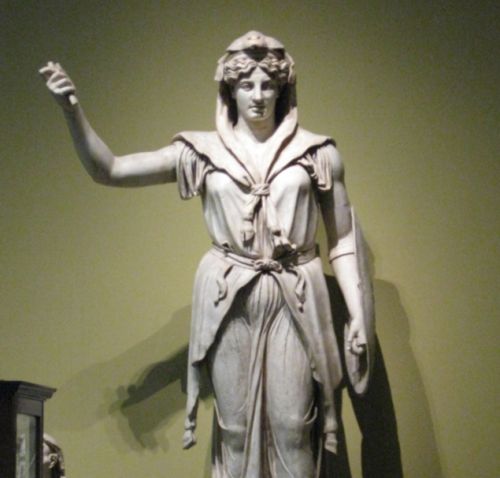
Regarded as the wife of Jupiter – the chief among the Roman gods, Juno was thus the queen of the ancient Roman deities, who was given the title of Regina. In the mythological genealogy, she was also the daughter of Saturn (which in turn also made her the sister of Jupiter) and the mother of various other Roman gods like Mars, Vulcan, and Juventas.
More importantly, she was also considered an esteemed member of the Capitoline Triad (Juno Capitolina) that replaced the earlier so-named Archaic Triad, and her place of worship was possibly centered on the Quirinal Hill in Rome.
Now when it comes to her attributes, Juno has been often likened to Hera, the queen of the ancient Greek pantheon of gods. And while the Roman goddess does share some of her Greek counterpart’s divine qualities, the entity of Juno is far older than the Roman occupation of the Greek peninsula, which further led to ‘counter’ Hellenic influence on the Italian peninsula.
To that end, the first of foremost roles of Juno was that of the protector of the state, and by extension of that role, Juno was also perceived as a deity who presided over all the matters of women, ranging from childbirth to legal statuses.
Interestingly enough, she was often depicted wearing a goatskin while carrying a spear and shield, thus also signifying the possible influence of Athena. In any case, Juno’s own festival was known as Matronalia. And while the day celebrated her son Mar’s birthday, husbands were actually expected to give their wives gifts during the occasion.
Neptune – The God of Seas (Equivalent of Greek Poseidon)

Regarded as the brother of Jupiter, Neptune (Neptunus in Latin) was the main god of both freshwater and the sea in the ancient Roman pantheon. Neptune was long considered one of the major Roman gods (along with his female counterpart, Salacia) of freshwater springs and inland water bodies – possibly by virtue of the entity’s Indo-European origins.
However, his specific association with the sea was probably the result of the deity’s identification with the Greek mythological counterpart of Poseidon, by circa 399 BC. Suffice it to say, inspired by these later associations, Neptune was often depicted like Poseidon with his characteristic trident, especially in the artworks of North Africa.
And much like his Greek counterpart, Neptune was also worshiped as one of the Roman gods of horses – in the form of Neptunus Equester, the patron deity of horse racing. Interestingly enough, while Rome only had a single temple dedicated to Neptune (near Circus Flaminius), Neptunalia possibly was an important (though somewhat obscure) festival celebrated in the height of summer.
During the occasion, when water levels were at their scarcest, people were devoted to the conservation and draining of superficial waters, while ritually participating in drinking spring waters and wine.
Minerva – The Goddess of Wisdom and Arts (Equivalent of Greek Athena)
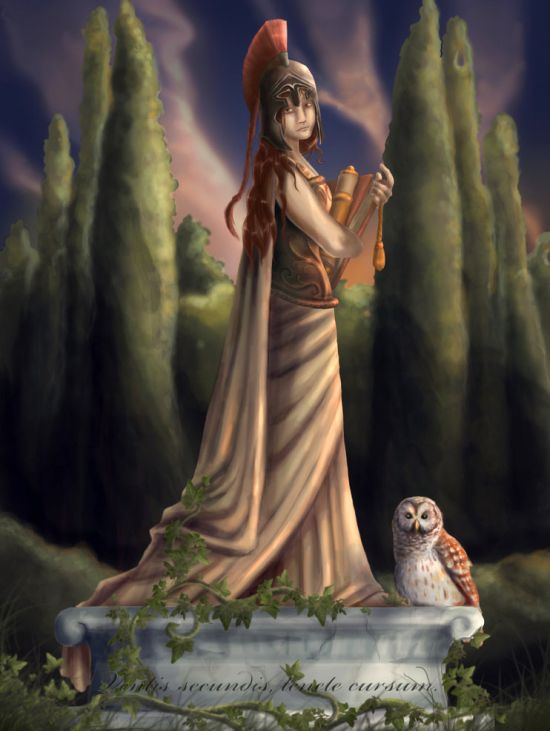
A Roman deity of varying avenues – ranging from wisdom, poetry, and medicine to art, crafts, and commerce, Minerva was aptly called the ‘goddess of thousand works’ by Ovid. When it comes to the genealogy of Roman gods, Minerva was said to come out from Jupiter’s forehead after the supreme god swallowed her mother Metis.
Interestingly enough, according to the mythic narrative, Jupiter committed such a bizarre act in the first place out of fear of a prophecy that Metis‘ child would one day challenge his order in the pantheon.
Pertaining to this episode, Minerva was also considered as the patron of war, more specifically strategic warfare – though this attribute was possibly a later addition in the 2nd century BC, which made Minera the equivalent of the Greek goddess Athena.
However, when it comes to history, most scholars agree that like many Roman gods and goddesses, Minerva had older origins. In her case, the indigenous Italic predecessor was probably the Etruscan goddess Menrva, while the name in itself is derived from meminisse, meaning ‘to remember’. She was also the third member of the Capitoline Triad and the patron of the Quinquatras.
This festival, while marking the start of the campaign season for the Roman army, was known for its four days of gladiatorial contests. Essentially, Minerva epitomized the aspects of both warfare and its consequences – including possible peace, as opposed to the more direct allusion to war (like in the case of Athena).
However, in spite of her more complex attributes, Minerva was depicted as being draped in her simple attire in the form of a chiton (an ancient Greek garment), while wearing a helmet and carrying a spear and a shield.
Mars – The God of War (Equivalent of Greek Ares)
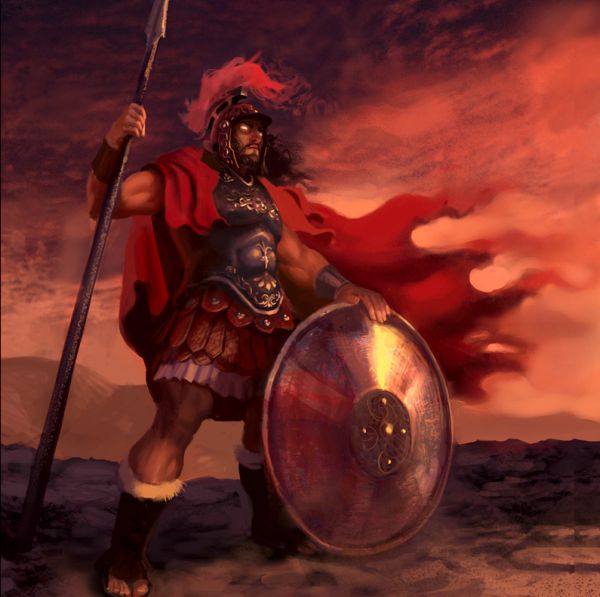
Considered the second in importance after Jupiter in the pantheon of Roman gods, Mars was the deity of war (and possibly agriculture). And while the aspect of military conflict often brings out the inevitable comparison with his ancient Greek equivalent Ares, Mars was arguably far more complex when it came to his martial attributes.
In essence, as opposed to the sheer impulsiveness and chaotic nature of warfare, Mars was perceived as a more composed and judicious entity that took up the role of the protector of Rome and its way of life. He was also venerated as the defender of the city and state borders, and all these aspects suggest how the embodiment of warfare was central to the collective consciousness of the Romans.
The mythical narrative rather reinforced the association of (practical) war to the early Romans, with Mars being portrayed as the father of the legendary founders of Rome – Romulus and Remus. To that end, the month of March (named after him, derived from Latin Martius) was reserved for the beginning of military campaigns, while also corresponding to many of the festivals of Mars.
Furthermore, the altar of Mars in Campus Martius (Field of Mars) was uniquely dedicated to the ancient god of war by the seemingly peace-loving Numa, the legendary second king of Rome. All of these cultural factors make Mars one of the exclusive ancient Roman gods who possibly had no parallel in the proximate Greek culture (in spite of sharing some qualities with Ares).
Venus – The Goddess of Beauty and Love (Equivalent of Greek Aphrodite)
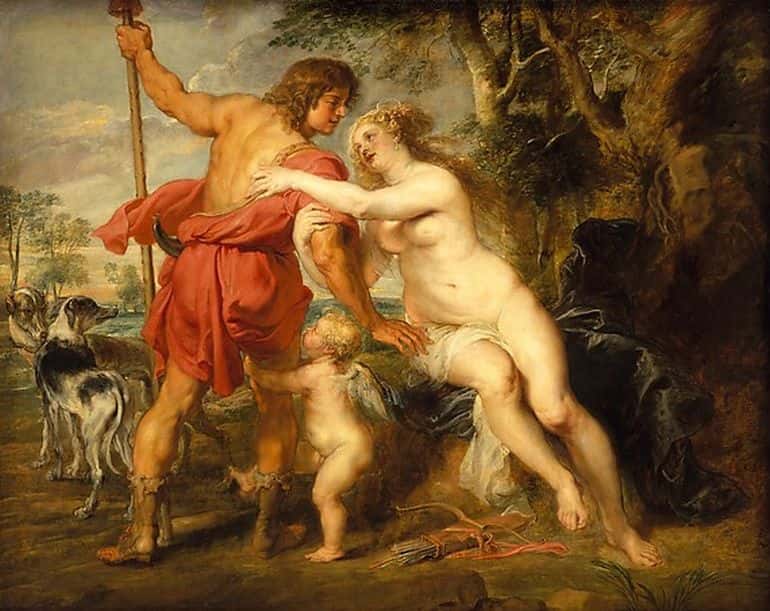
The ancient Roman deity of beauty, love, desire, and sex, Venus is often perceived as the equivalent of the Greek goddess Aphrodite. However, like in the case of some of the earlier mentioned Roman gods, Venus as a divine entity possibly epitomized more aspects than her Greek counterpart – since she was also regarded as the goddess of victory and fertility (and possibly even prostitution).
In any case, it was the embodiment of the concepts of beauty, sex, and desire that formed the core of her attributes, so much so that the Latin noun venus also meant ‘sexual love’ or sexual desire.
Given the overtones of sexuality and fertility, it doesn’t come as a surprise that Venus bore many children when it comes to the scope of her mythical narrative. For example, her illicit love affair with Mars produced the twins Timor (Phobos in Greek) and Metus (Deimos in Greek), the personifications of fear and terror respectively, Concordia (Harmonia in Greek), the goddess of harmony and concord, and Cupids (Erotes in Greek), the famed winged deities of love.
Ovid provided his narrative on how Venus (or rather Venus-Aphrodite) was also the mother of Hermaphroditos (compound of his parents’ names Hermes and Aphrodite), while Fortuna, the goddess of luck and fate, was regarded as the offspring of Venus and Jupiter (or Hermes).
Apollo – The God of Light and Prophecy (Similar to the Greek Apollo)
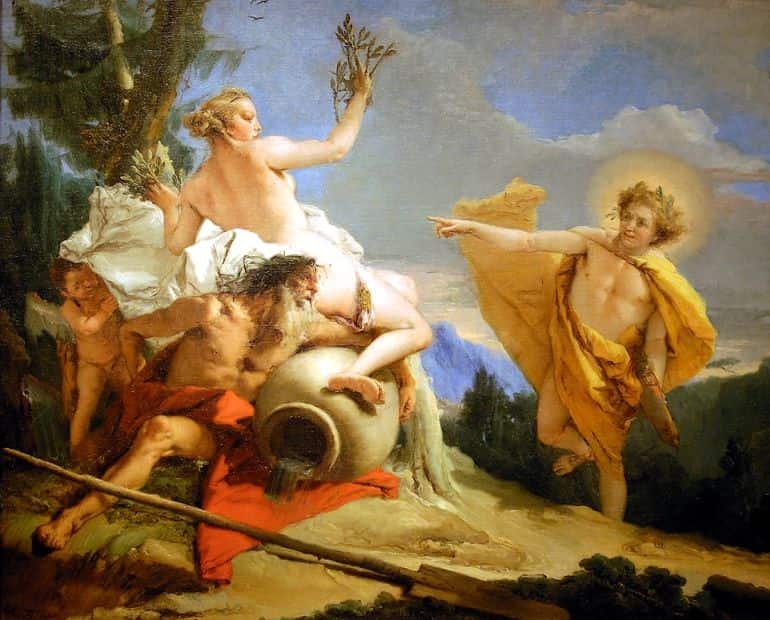
Hailed as one of the most important Olympian deities when it came to the pantheons of both ancient Greek and Roman gods, Apollo, the archetype of the beardless, youthful being (kouros), was considered the divine entity of light, music, prophecy, poetry, medicine, and even archery.
Now interestingly enough, Apollo can be counted among the rare Roman gods who had directly originated from Greek mythology (thus having no Roman equivalent), with the cult centers of the entity in Delphi and Delos being in existence since the 8th century BC.
And even the origins of Apollo in the Greek pantheon are mired in mystery, with the etymology of the word Apollon (‘Apollo’ is the Latin form of Greek ‘Apollon’) possibly harking back to a pre-Greek era. For example, a Hittite entity Apaliunas is mentioned in the Manapa-Tarhunta letter, which in turn might have been derived from Aplu Enlil – meaning the son of the Mesopotamian god Enlil.
In any case, coming back to the Roman scope, Apollo, regarded as the son of Jupiter, was often venerated with the epithet of Phoebus (derived from Phoibos, meaning ‘bright’), and his first temple was possibly established by the late 5th century BC in the Flaminian fields.
However historically, it was Augustus who encouraged the worship of Apollo as one of the major Roman gods, especially after his victory at the Battle of Actium (circa 31 BC) that fought near the sanctuary of the deity. During his reign as the first Roman emperor, Augustus went on to institute the quinquennial games in honor of Apollo, while also building a new temple dedicated to the god on the Palatine Hill.
Diana – The Goddess of Hunt and The Moon (Equivalent of Greek Artemis)
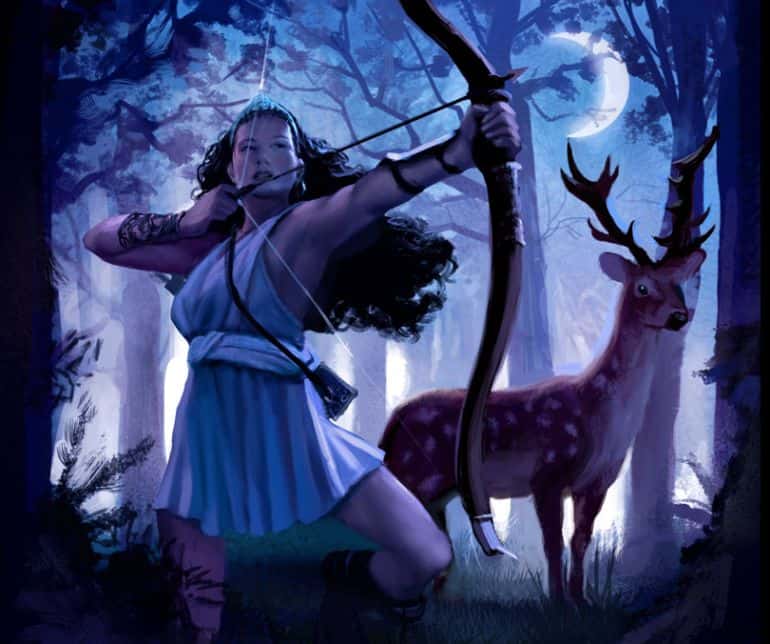
A female deity characterizing the hunt, wildlands, nature, and the moon among the ancient Roman gods, Diana was also regarded as an entity that was antithetically the virgin goddess of childbirth and women. In essence, she belonged to the triad of female Roman goddesses (along with Minerva and Vesta) who were maidens; and the mythical narrative often portrayed her as the twin sister of Apollo and daughter of Jupiter.
And while she is often equated to her Greek counterpart Artemis, the origins of Diana probably harked back to an indigenous Italic (or older Indo-European) entity. Ist century BC Stoic philosopher Quintus Lucilius Balbus (noted by Cicero in his book De Natura Deorum or ‘On the Nature of the Gods’), discussed –
people regard Diana and the moon as one and the same. … the moon (luna) is so called from the verb to shine (lucere). Lucina is identified with it, which is why in our country they invoke Juno Lucina in childbirth, just as the Greeks call on Diana the Light-bearer.
Diana also has the name Omnivaga (“wandering everywhere”), not because of her hunting but because she is numbered as one of the seven planets; her name Diana derives from the fact that she turns darkness into daylight (dies). She is invoked at childbirth because children are born occasionally after seven, or usually after nine, lunar revolutions…
Interestingly enough, as was virgin Diana’s paradoxical connection to childbirth, the goddess also embodied other seemingly conflicting aspects, ranging from the purity and serenity of woods and wildlands to the unpredictable and ever-changing nature of the moon. On occasions, she was also considered one of the Roman gods of the dark world of the dead, thus being the equivalent of the Greek goddess Hecate.
Vulcan – The God of Fire and Metallurgy (Equivalent of Greek Hephaistos)
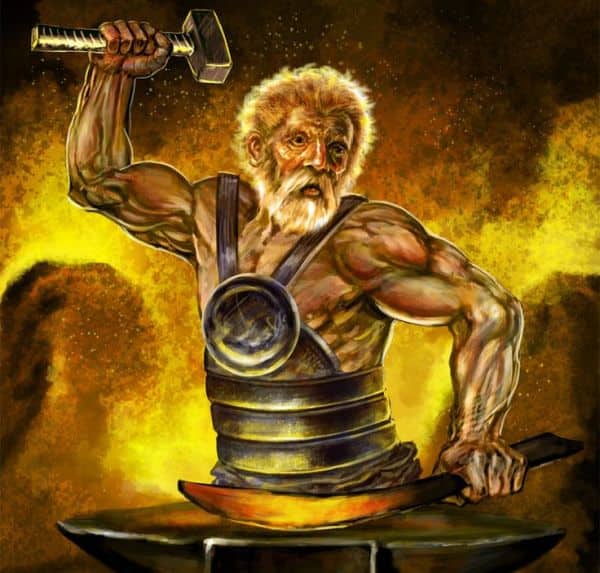
One of the oldest of Roman gods, the figure of Vulcan (Vulcānus in Latin)possibly harks back to Rome’s archaic times, circa 7th century BC. As for his attributes, Vulcan was considered the Roman god of fire (including volcanoes), metallurgy, and forges. Pertaining to the latter, Vulcan’s own forge was believed to be situated beneath Mount Aetna in Sicily.
Now interestingly enough, the oldest sanctuary of Vulcan, known as the Vulcanal (or Volcanal) was probably situated at the foot of the Capitoline Hill, and this site revealed a Greek pottery fragment (dated to circa 6th century BC) that possibly depicted Hephaestus (or Hephaistos), the Greek god of fire and metalworking.
In essence, Vulcan was probably one of the earlier Roman gods who was equated to an ancient Greek counterpart. At the same time, Vulcan also matched the aspects of Sethlans, an ancient Etruscan god. Quite intriguingly, in spite of the word ‘volcano’ being derived from Latin Vulcānus, scholars are divided in their hypotheses when it comes to the origins of the word Vulcānus itself.
To that end, according to some the word is derived from Latin fulgur, with connections to lightning and flames, while others have conjectured that the term originates from Cretan Minoan god Velchanos.
In any case, the Romans celebrated Vulcanalia, the festival of Vulcan, at a time in the year (in August) when the crops and grains had the greatest chance of catching fire from the heat. So in a bid to appease the god of fire, the citizens made ceremonial bonfires – into which sacrificial fishes and small animals were thrown.
Vesta – The Goddess of Domesticity (Equivalent of Greek Hestia)
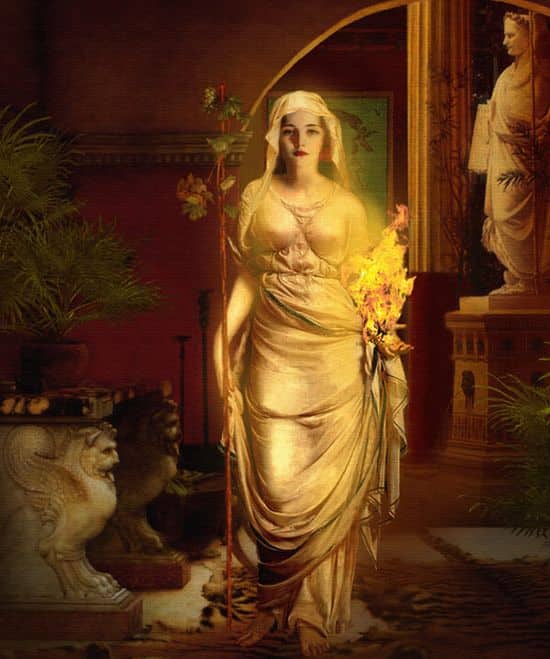
The daughter of Saturn and sister of Jupiter, Vesta was paradoxically considered the oldest and youngest of Roman gods since she was the first to be swallowed by Saturn (or Greek equivalent Cronus) and last to be released from the ‘confines’ of her father. And in the mythical narrative, in spite of being beautiful, she rejected the advances of other divine suitors like Apollo and Neptune.
Instead, she appealed to Jupiter to allow her to remain a virgin. Thus Vesta came to be associated as the Roman goddess of the hearth, home, and domestic scope – and her Greek equivalent was Hestia, the ancient entity representing domesticity, family, and architecture. Interestingly enough, the Latin term for hearth is focus (which in English means ‘the center of interest or activity’), thus suggesting how the fire burning in this particular area of the house figuratively signified the ‘convergent spirit’ of the entire family.
The fire also played an important role in the shrine of Vesta in the Roman Forum, where it was perpetually burned and tended to by the Vestal Virgins (Vestales in Latin), the priestesses of the deity. As their name suggests, these Vestal Virgins, chosen at the young age of six to ten, were to remain chaste for a service period of 30 years.
And such was the nature of this guarded scope of worshipping that the shrine of Vesta was not opened to the public, except during the festival of Vesta, known as Vestalia (celebrated in June) – during which barefooted matrons visited the sanctuary to give their offerings.
And quite intriguingly, the eminence of Vesta among the Roman gods is mirrored by the fact that her cult was one of the last pagan institutions to be disbanded by the Christian emperor Theodosius I in 391 AD, after almost a thousand years of the burning of the sacred fire.
Mercury – The God of Wealth (Equivalent of Greek Hermes)
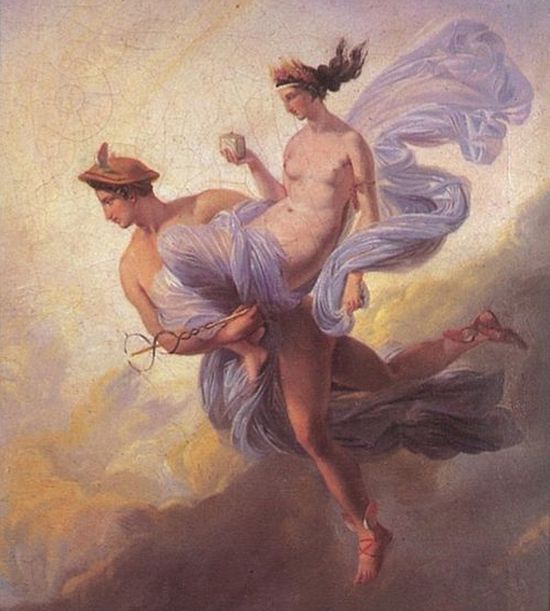
One of the relatively ‘later’ ancient Roman gods, Mercury was possibly the composite of various earlier di indigites (indigenous Roman gods) who represented wealth and trade. In essence, Mercury (Mercurius in Latin, possibly derived from merx or ‘merchandise’) was considered the Roman deity of commerce and financial gains, whose attributes also stretched to various other avenues like communication, divination, eloquence, thievery, and gymnastics.
And in spite of being related to the Etruscan god Turms, by the time of the Roman Republic (circa 3rd century BC), Mercury was often equated to his ancient Greek counterpart Hermes (the messenger god), which resulted in his depiction with apparel like the winged sandals (talaria) and a winged hat (petasos).
Interestingly enough, Mercury was also among the Roman gods whose aspects played a syncretic role when it came to the scope of worship of similar deities from other ancient cultures. For example, Julius Caesar mentioned how Mercury was a rather popular divine entity in Gaul and Britain. This may have been due to the Roman cultural trait of interpretatio Romana, wherein the Romans tended to interpret various native divine entities in accordance with their own pantheon.
To that end, Mercury might have been equated to the Celtic sun god, Lugus, who in spite of being the god of light, also bore aspects that symbolized trade and commerce. By virtue of the same cultural trait, Tacitus mentioned how Mercury was also the chief god of the Germanic people, possibly being the equivalent of native Wotan.
Ceres – The Goddess of Agriculture (Equivalent of Greek Demeter)
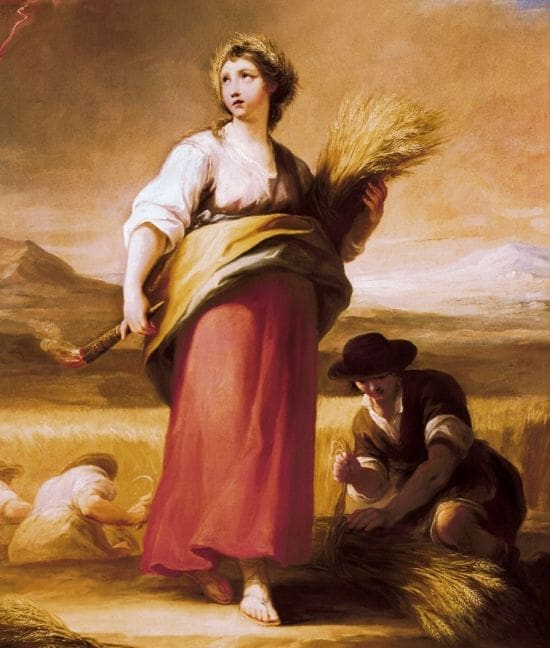
A female entity representing agriculture, crops, fertility, and motherly relationships, Ceres was venerated as a kind and benevolent deity among the ancient Roman gods. When it comes to the mythical narrative, Ceres was considered the daughter of Saturn and sister of Jupiter, but the main element of her worship and veneration was focused on the relationship between Ceres and her own daughter Proserpine.
Essentially, this translated to a tragic story in which Ceres lost her daughter when she was kidnapped by Pluto, the god of the underworld. And even after the intervention of other gods, including their leader Jupiter, Proserpine was only allowed to return to earth and spend time with her mother from spring to autumn, thus essentially symbolizing how her parting caused the leaves to fall and stunted nature’s growth – until the cyclic arrival of next spring.
The aforementioned narrative mythology does mirror the Greek mythology concerning the goddess Demeter and her daughter Persephone, thus partially making Ceres the Roman equivalent of Demeter. And when it comes to history, there was an ancient Roman festival of Cerealia that was held for 7 days in April in honor of Ceres.
And on the occasion (according to Ovid’s Fasti), people used to tie blazing torches to the tails of foxes, who were then ceremoniously let loose into the expansive space later known as Circus Maximus – as a symbolic punishment for the creatures’ yearly forays into Roman croplands that were sacred to Ceres. (*also check this citation).
The festival was also marked by what can be termed as collective cosplay with Roman women dressing in white attires to mimic Ceres, who wandered through the earth in lamentation for her abducted daughter Proserpine. Furthermore, pertaining to one of the most commonly uttered words by parents in the mornings of the Western Hemisphere, the term ‘Cereal’ also comes from Ceres.
Bacchus – The God of Wine and Revelry (Equivalent of Greek Dionysus)
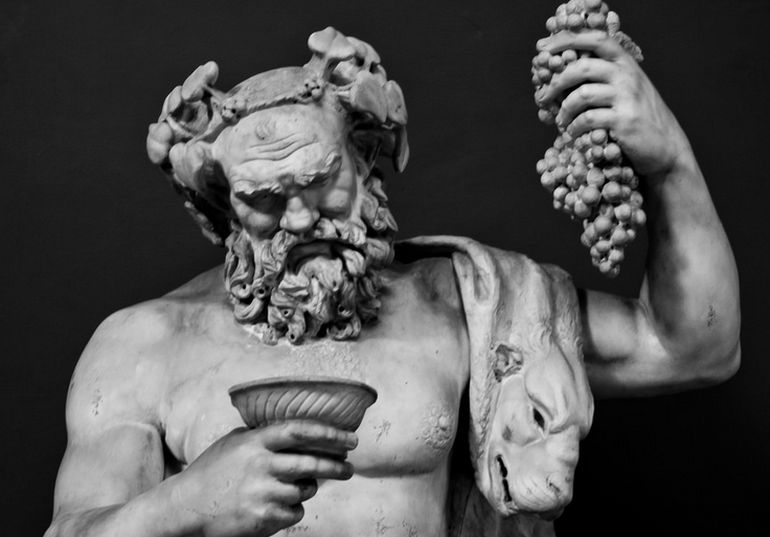
While the aforementioned Apollo maintained his compatible name in the pantheons of Greek and Roman gods, Bacchus was a straight-up Romanized equivalent of the Greek god Dionysus. To that end, Bacchus could be perceived as a latent ‘copy’ of Dionysus, thus being associated with similar mythical narratives (albeit with Romanized characters, like being considered as the son of Jupiter instead of Zeus) and traits.
In essence, Bacchus was the Roman god of both wine and winemaking, while also embodying the fascinating (and rather mysterious) aspects of ritual madness and religious ecstasy. Pertaining to the latter characteristics, Bacchanalia was the blanket term for the Roman festivals dedicated to this god. Possibly centered around the Dionysian mysteries (involving intoxicants and trance-inducing moves like rhythmic dancing), the initiates of such private ceremonies were bound to secrecy.
Consequently, the ancient rites of Bacchus in some part remain mysterious and were rather scandalous during their time, as was attested by Livy, who talked about how the cults practiced wine-fueled violence and rampant sexual promiscuity, accompanied by cacophonous music – thus giving way to the term ‘bacchanalian’, meaning a ‘drunken feast’.
Intriguingly enough, Bacchus was later associated with the indigenous entity of Liber Pater (‘the free Father’), one of the Roman gods of viticulture and wine, fertility, and freedom. During his festival (Liberalia – which later merged with bacchanalian practices), the feast marked the coming-of-age of the Roman teenagers who crossed the threshold of 14 or 15 years. And in an interesting ritual, the teenager as a mark of his new-found manhood had to place a lock of hair from the first shave of his stubble inside a bulla (pendant) on an altar.
Honorable Mention – Mithras: The ‘Syncretic’ God
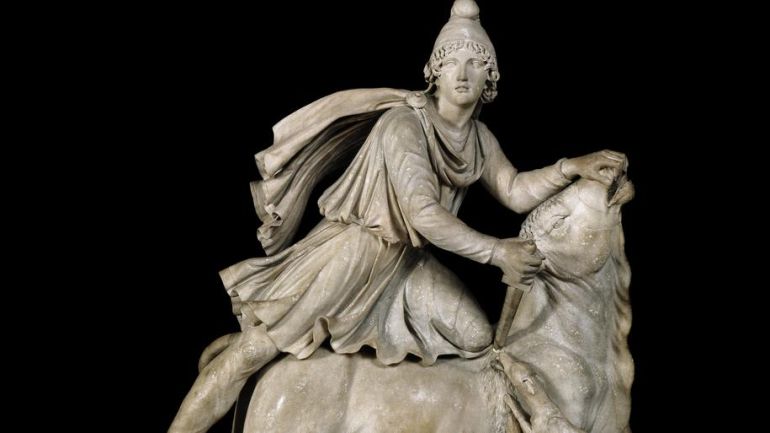
Mithra was incipiently a Zoroastrian divine entity (yazata), thus having its origins in the religious system of ancient Persia and related Indo-Iranian traditions. However, pertaining to a fascinating example of cross-cultural syncretism, a mystery religion centered around a particular Greco-Roman deity known as Mithras (a figure which was inspired by Mithra) was practiced in the Roman Empire, with its heydays ranging from 1st to the 4th century AD – thus possibly being one of the early ‘rivals’ to Christianity.
And while the name and the initial divinity of Mithras were influenced by its Eastern counterpart, the imagery of this enigmatic deity among the Roman gods along with the related belief system was distinct from the original Zoroastrian entity.
Mainly practiced by the members of the Roman military, this mystery religion of Mithraism (possibly transmitted by the merchants from the east) was primarily introduced into the upper echelons of the society, circa 1st century AD. And by the 3rd century AD, the cult, probably open to only males, percolated into different sections of society, with one of the major bastions being the eternal city itself – Rome.
These male initiates, known as syndexioi, probably met in underground temples called mithraea. Quite intriguingly, while the imagery of Mithras is well known with the god’s depiction as a youth wearing an Anatolian attire and a Phrygian cap in a bull-slaying scene, historians are still perplexed by a lion-headed figure often encountered in Mithraic temples. Known as Arimanius (a Latinized form of the name Ahriman – a demonic entity in the Zoroastrian pantheon), the cryptic deity possibly represented Cronus or his Eastern equivalent.
Family Tree of Roman Gods and Goddesses

Featured Image Source: Imperial College London
And in case we have not attributed or misattributed any image, artwork, or photograph, we apologize in advance. Please let us know via the ‘Contact Us’ link, provided both above the top bar and at the bottom bar of the page.
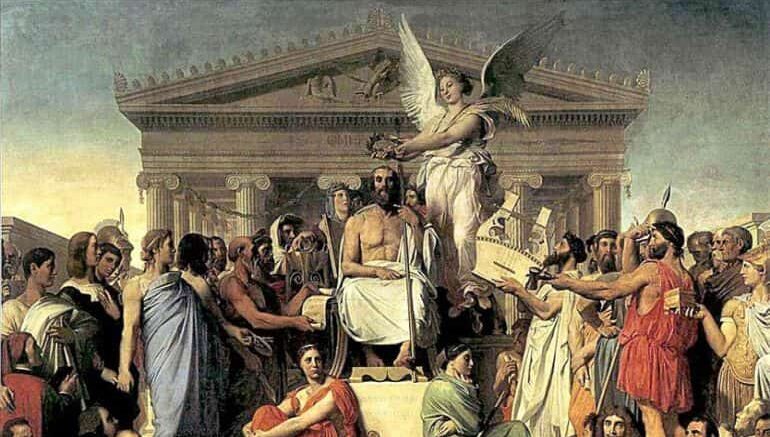

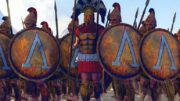


Be the first to comment on "15 Remarkable Roman Gods and Goddesses"